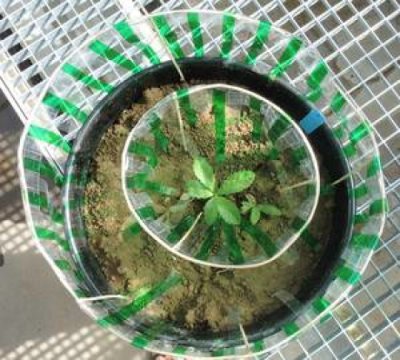Can Plants Be as Smart as Animals?
Seeking to thrive and grow, plants communicate extensively, without a mind or a brain
In an experiment, Potentilla reptans grows tall, wide, or shade-tolerant, depending on what neighbors (simulated by varying stripes) do/Udi Segev
Recently, we’ve been discussing intelligence in life forms such as birds, reptiles, and invertebrates. Contrary to what we might expect, animal intelligence does not seem to depend either on the details of the brain’s organization or on a hierarchy based on genetics or common descent.
Octopuses, for example, are quite bright but very distant genetically from primates. Yet many of the octopus’s fellow molluscs are very dim indeed. If we are going to talk about artificial intelligence, it wouldn’t hurt to spend some time with the puzzles of natural intelligence.
Which brings us to plants. Unlike even insects, whose brains “are far too complex to be fully understood in the near future” (Scientific American, 2013), plants do not have a brain. How then could they communicate or learn?
One science writer, while ridiculing mystical claims about plant intelligence, admits,
There’s no doubt that plants do some amazing things. When being eaten by caterpillars, cotton plants release signals that attract insect-eating parasitic wasps to attack the caterpillars. Bean plants in close proximity to each other seem to communicate if one is under attack. Bean plants connected by symbiotic fungus will raise their chemical defenses if a compatriot is besieged by aphids. Mimosa plants even seem to have a basic memory. While the sensitive plants usually curl up when touched or dropped, scientist Monica Gagliano got them to ditch their regular response by repeatedly exposing them to a harmless six-inch fall to a cushioned surface. Ross Pomeroy, “Do Plants Behave Like Animals?” at RealClearScience
Because plants are chemical factories, among other things, they can mimic the senses an animal has by using electrical or chemical signals. In a study published in Nature Communications, researchers report that plants can “evaluate the competitive ability of their neighbors and optimally match their responses to them.” Some plants, for example, use flashes of fluorescent light to warn leaves against insects.
From a 2014 report on a study of plants releasing chemicals against aphids that were picked up as signals by other plants:
Researchers are unearthing evidence that, far from being unresponsive and uncommunicative organisms, plants engage in regular conversation. In addition to warning neighbors of herbivore attacks, they alert each other to threatening pathogens and impending droughts, and even recognize kin, continually adapting to the information they receive from plants growing around them. Moreover, plants can “talk” in several different ways: via airborne chemicals, soluble compounds exchanged by roots and networks of threadlike fungi, and perhaps even ultrasonic sounds. Plants, it seems, have a social life that scientists are just beginning to understand. Dan Cossins, “Plant Talk” at The Scientist
Actually, none of the plants’ extensive “social life” requires reason, emotion, value systems, mind, consciousness, or a sense of self. It requires only that the plant, like an animal, seek to continue its highly organized existence. Plants’ ability to process information for that purpose gives pause for thought.
The sheer complexity of the communications systems plants demonstrate astonishes us to the point that scientists have refused to believe the evidence. In 1983, plant scientists Jack Schultz and Ian Baldwin reported that maple saplings that were exposed to maples damaged by herbivores increased their own defenses. They attributed the increase to the chemical signals released by the injured trees, signals to which the saplings responded.
But, as Cossins recounts, many researchers would not accept that plants could behave so as to benefit neighboring plants but not themselves. Such behavior contradicted evolution theory; it would not be “evolutionarily stable.” However, by 2000, the behavior was demonstrated in a number of species, with the signals being picked up by both members of the sending plant’s own species and by other species as well.
Plants show the extent to which communication is possible without any of the qualities we associate with individual intelligence, provided the entity seeks to thrive and grow. Time will tell if an artificial entity that is not and never has been alive can be enabled to “seek” the same things.
See also: Crows Can Be as Smart as Apes But they have quite different brains.
Even Lizards Can Be Smart If you catch them at the right time. But can we give machines what the lizard has by nature?
Is the octopus a “second genesis” of intelligence?
and
Does intelligence depend on a specific type of brain?

